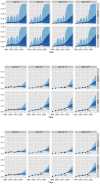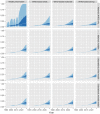A Bayesian approach to combining multiple information sources: Estimating and forecasting childhood obesity in Thailand
- PMID: 35061753
- PMCID: PMC8782526
- DOI: 10.1371/journal.pone.0262047
A Bayesian approach to combining multiple information sources: Estimating and forecasting childhood obesity in Thailand
Abstract
We estimate and forecast childhood obesity by age, sex, region, and urban-rural residence in Thailand, using a Bayesian approach to combining multiple source of information. Our main sources of information are survey data and administrative data, but we also make use of informative prior distributions based on international estimates of obesity trends and on expectations about smoothness. Although the final model is complex, the difficulty of building and understanding the model is reduced by the fact that it is composed of many smaller submodels. For instance, the submodel describing trends in prevalences is specified separately from the submodels describing errors in the data sources. None of our Thai data sources has more than 7 time points. However, by combining multiple data sources, we are able to fit relatively complicated time series models. Our results suggest that obesity prevalence has recently starting rising quickly among Thai teenagers throughout the country, but has been stable among children under 5 years old.
Conflict of interest statement
The authors have declared that no competing interests exist.
Figures







References
-
- Hand DJ. Statistical challenges of administrative and transaction data. Journal of the Royal Statistical Society: Series A (Statistics in Society). 2018;181: 555–605. doi: 10.1111/rssa.12315 - DOI
-
- Gregory IN, Marti-Henneberg J, Tapiador FJ. Modelling long-term pan-European population change from 1870 to 2000 by using geographical information systems. Journal of the Royal Statistical Society: Series A (Statistics in Society). 2010;173: 31–50. doi: 10.1111/j.1467-985X.2009.00598.x - DOI
-
- Hyndman RJ, Athanasopoulos G. Forecasting: Principles and practice. Third edition [Internet]. OTexts; 2021. Available: https://otexts.com/fpp3/
MeSH terms
LinkOut - more resources
Full Text Sources
Medical

